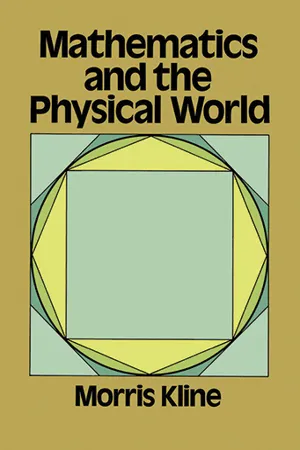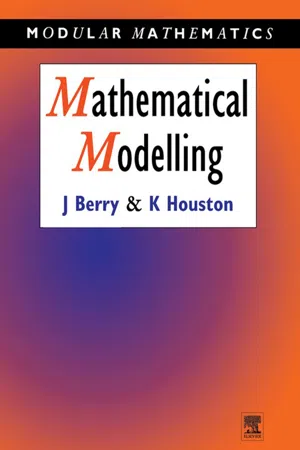Mathematics
The Trajectory of a Projectile
The trajectory of a projectile is the path it follows through the air. It is determined by the initial velocity, angle of launch, and the effects of air resistance and gravity. The shape of the trajectory is a parabolic curve.
Written by Perlego with AI-assistance
Related key terms
9 Key excerpts on "The Trajectory of a Projectile"
- eBook - ePub
Sports Biomechanics
The Basics: Optimising Human Performance
- Prof. Anthony J. Blazevich(Author)
- 2017(Publication Date)
- Bloomsbury Sport(Publisher)
CHAPTER 3 PROJECTILE MOTIONBy the end of this chapter you should be able to:What is the optimum angle of trajectory or flight path (that is, the angle thrown relative to the ground) for a shot-putter aiming to throw the maximum distance? (Hint: not 45°.) What factors affect maximum throwing distance and to what degree?• List the factors that influence an object’s trajectory• Use the equations of projectile motion to calculate flight times, ranges and projection angles of projectiles• Design a simple model to determine the influence of factors affecting projection range• Create a spreadsheet to speed up calculations to optimise athletic throwing performance• Complete a video analysis of a throw to optimise performanceProjectile motion refers to the motion of an object (for example a shot, ball or human body) projected at an angle into the air. Gravity and air resistance affect such objects, although in many cases air resistance is considered to be so small that it can be disregarded. A projected object can move at any angle between horizontal (0°) and vertical (90°) but gravity only acts on bodies moving with some vertical motion.Trajectory is influenced by the projection speed, the projection angle and the relative height of projection (that is, the vertical distance between the landing and release points; for example, in a baseball throw that lands on the ground, the vertical distance is the height above the ground from which the ball was released).FIG. 3.1 Tennis ball trajectory. Gravity accelerates the ball towards the ground at the same rate regardless of whether the tennis player leaves the ball to fall freely or hits it perfectly horizontally. However, the trajectory of the ball is different in these two circumstances.Projection speedThe distance a projectile covers, its range, is chiefly influenced by its projection speed. The faster the projection speed, the further the object will go. If an object is thrown through the air, the distance it travels before hitting the ground (its range) will be a function of horizontal velocity and flight time (that is, velocity × time, as you saw in Chapter 1 ). In Figure 3.1 - eBook - ePub
Doing Physics with Scientific Notebook
A Problem Solving Approach
- Joseph Gallant(Author)
- 2012(Publication Date)
- Wiley(Publisher)
Chapter 4Projectile Motion
The 1-dimensional kinematics of Chapter 2 allow us to describe horizontal or vertical motion in a straight line. Vectors allow us to analyze 2-dimensional objects. Now we combine the two and use vectors to describe 2-dimensional motion. A 2-d kinematics problem is really two 1-d kinematics problems and we use vectors to break the analysis into components.One example of 2-d motion is projectile motion, where an object is launched with an initial velocity and then is influenced only by gravity and air resistance. The object’s initial coordinates are x0 and y0 . Its initial velocity has magnitude v0 and direction θ0 above the horizontal.The horizontal component of the initial velocity is vox = v0 cos θ0 and the vertical component is voy = v0 sin θ0 . This unusual notation is due to a limitation of SNB: the engine can’t handle a double subscript unless the indices are either both numbers or both letters. So we’ll use vox instead of vox and voy instead of v0y. Here is a summary of the notation for the velocity and position of our projectile.Table 4.1With the equations of 1-dimensional kinematics and vectors, we can analyze projectile motion with and without air resistance. We will calculate the horizontal position x and the height y as functions of time directly and separately, and calculate the trajectory, the mathematical description of the path of the projectile that gives the projectile’s height as a function of horizontal position. We will also calculate how far the projectile travels horizontally before landing, how much time it spends in the air, and its maximum height.No Air Resistance
In the absence of air resistance, the only influence on the projectile is gravity. Near the Earth’s surface, the acceleration due to gravity is constant so we can use Eqs. (2.5) and (2.6) - eBook - ePub
- Hiqmet Kamberaj(Author)
- 2021(Publication Date)
- De Gruyter(Publisher)
the x, y and z axes. 4.3 Projectile motion We often have observed a baseball in motion or any other object thrown into the air, such as an arrow shown in Fig. 4.5. By definition, this kind of movement is called projectile motion. Figure 4.5 An example of the projectile motion. v total represents the total velocity at any point of the projectile motion; v x and v y are, respectively, the x and y components. α is the angle formed by the direction of v total and x -direction, which varies from point to point along the trajectory. Assumptions of projectile motion In this motion, the ball follows a curved path, and its motion is simple to analyze if we make two assumptions: 1. The free-fall acceleration g is constant over the range of motion and is directed downward. 2. The effect of air resistance is negligible. Taking into account these assumptions, we will find in the following that the projectile motion’s path of a projectile (or the trajectory) is always a parabola. To show this, we consider the projectile motion in a reference frame such that the y -axis is vertical, and its positive direction is upward. Since the air resistance is neglected, we know that a y = − g (as in one-dimensional free fall) and that a x = 0. Also, the projectile is initially (t = 0) positioned at the origin (x i = y i = 0) with velocity v i, as shown in Fig. 4.6. The vector v i makes an angle θ i with the horizontal, where θ i is the initial angle (at the origin) between the direction of v i vector and the x -direction. Figure 4.6 Projectile motion of the baseball. From the definitions of the cosine and sinus functions, we obtain the x and y components of the initial velocity: (4.29) v x i = v i cos θ i v y i = v i sin θ i. Substituting the x component from eq. (4.29) into eq. (4.25) and taking x i = 0, a x = 0, we - eBook - ePub
- A. L. Stanford, J. M. Tanner(Authors)
- 2014(Publication Date)
- Academic Press(Publisher)
(2-23) , we may see that The Trajectory of a Projectile is a parabola. That parabolic path is an idealization that results from our having neglected air resistance. In actuality, a projectile moving through the air has an acceleration with both horizontal and vertical components. As a consequence, an actual projectile moving through air will neither rise as high nor travel as far as our analysis indicates.Equations (2 –19) through (2–24) describe projectile motion, and the examples and exercises that follow will suggest how specific information about projectile motion may be obtained. Here let us indicate how the velocity of the particle is determined at any instant during the flight of a projectile. Figure 2.8 shows the particle at an arbitrary point P in its trajectory. The velocity of the particle at this particular time is the vector sum of the horizontal and vertical components of velocity,Figure 2.8 The horizontal and vertical component vectors of the velocity v at an arbitrary point P on The Trajectory of a Projectile.v =(2-25)v xi ˆ+v yj ˆ(2-25)wherevxandvyare given by Equations (2–21) and (2-24) . The magnitude of the velocity isv=(2-26)v x2 +v y2(2-26)Its direction is tangent to the trajectory but is usually specified relative to one of the axes, such as the angle α measured from the horizontal direction in Figure 2.8 in whichα =(2-27)tan− 1()v yv x(2-27)Example 2.4PROBLEMA ball is thrown at t = 0 with an initial velocity v o = 100 ft/s /60° .(a) When does the ball reach its maximum height? (b) What is the maximum height attained by the ball?(c) What are the position (relative to its t = 0 position), velocity, and acceleration of the ball at the position of maximum height?SOLUTION The components of the initial velocity areThus, the position, velocity, and acceleration components of the ball arev=o xv ocos60 °=(100 ft/s)( 0.5 )= 50 ft/sv=o yv osin60 °=(100 ft/s)( 0.866 )= 87 ft/sx =vt =o x - Paul Grimshaw, Neil Fowler, Adrian Lees, Adrian Burden(Authors)
- 2007(Publication Date)
- Routledge(Publisher)
The Trapezium Rule is only an approximation of the true area under the curve because it assumes that the curve between two adjacent samples is a straight line. If the curve is not a straight line this will result in an error. These errors will be reduced if the time interval between samples is reduced. (The narrower the trapezium, the more closely the curve between the sides of the trapezium will approximate to a straight line). Although some error will always persist, for most practical purposes in biomechanics this method of integration is considered suitable.Passage contains an image
Section A – Kinematics of motion
A7 UNIFORMLY ACCELERATED AND PROJECTILE MOTIONKey NotesIntroductionNewton’s Second Law of Motion dictates that bodies which experience a constant force also accelerate at a constant rate. The most common example of this occurring on Earth is when a body is airbourne; where the attractive force between the body and the Earth provides an acceleration equal to −9.81 m·sec−2 .Effects of constant accelerationA body subjected to a constant acceleration will experience a linear change in velocity and a curvilinear change in position when viewed over time. At any point in time the motion of a body (e.g., its position or velocity) that is accelerating constantly can be calculated using one of Galileo’s equations of uniformly accelerated motion. These equations can be used to find, for example, the height raised by an athlete’s center of gravity (CG) during a jump.Projectile motionA projectile is a body that is unsupported (i.e., a ball in flight) and only affected by the forces associated with gravity and air resistance. Projectiles generally have both horizontal and vertical velocity components during flight. If air resistance can be ignored, the horizontal velocity remains constant and the vertical velocity is affected by the constant acceleration due to gravity; which results in the projectile having a parabolic flight path.Maximizing the range of a projectileFor a body that lands at the same height that it was projected from, its range is dependent upon both its velocity and angle of projection at takeoff. More specifically, range is proportional to the square of the take-off velocity; so higher velocities will result in proportionally greater gains in range. At any velocity, a take-off angle of 45° will result in the greatest range.- eBook - ePub
- Morris Kline(Author)
- 2012(Publication Date)
- Dover Publications(Publisher)
y values. The answer is easily obtained by algebra. By solving equation (7) for t we obtainIf we substitute this value of t in equation (9) we obtainor(10)Now A and V, the angle at which the projectile is fired and the velocity with which it is fired, are constants; hence so are sin A and cos A. Then equation (10) is of the form(11)where a = sin A /cos A and b = 16/V 2 cos2 A .The curve that corresponds to an equation of the form (11) is not immediately identifiable on the basis of our rather limited study of coordinate geometry. However, a slight extension of the study we made there of curve and equation would show that any equation of the form (11), and therefore equation (10) in particular, is a parabola which lies with relation to the axes as shown in figure 71 . The general conclusion, then, is that the path of a projectile fired at an inclination A and with an initial velocity V in the direction of fire is a parabola.Fig. 71Let us now proceed to answer some of the questions that troubled Galileo and his contemporaries. How high will a projectile go if fired at a given angle, and how long will it take to reach that height?To be specific, let us suppose that a projectile is fired at an angle of 53° with a muzzle or initial velocity of 128 feet per second. (These numbers have been chosen merely to make the arithmetic easier.) To answer the question of how high the projectile will go, that is, how large y1 in figure 72 is, we note first that the vertical motion is governed solely by formulas (8) and (9). However, while these formulas give us the vertical velocity and vertical height at any time they do not in themselves tell us the value of t when the projectile is at its maximum height. What fact about the motion does single out this value of t? - No longer available |Learn more
MCAT Physics and Math Review 2024-2025
Online + Book
- (Author)
- 2023(Publication Date)
- Kaplan Test Prep(Publisher)
x-direction, one can find the horizontal distance traveled.Projectile Motion
Projectile motion is motion that follows a path along two dimensions. The velocities and accelerations in the two directions (usually horizontal and vertical) are independent of each other and must, accordingly, be analyzed separately. Objects in projectile motion on Earth, such as cannonballs, baseballs, or footballs, experience the force and acceleration of gravity only in the vertical direction (along the y-axis). This means that vywill change at the rate of g but vxwill remain constant. In fact, on the MCAT, you will generally be able to assume that the horizontal velocity, vx, will be constant because we usually assume that air resistance is negligible and, therefore, no measurable force is acting along the x-axis.KEY CONCEPT
Note that gravity is set in bold, indicating it has a vector value. Gravity is unique in that it is used as both a constant and as a vector in calculations. Though gravity is not always bolded, you should recall for Test Day that gravity has a direction.Example:A projectile is fired from ground level with an initial velocity of50and an initial angle of elevation of 37°, as shown below. Assumingm sg = – 10find the following: (Note: sin 37° = 0.6; cos 37° = 0.8)m,s 2- The projectile’s total time in flight
- The total horizontal distance traveled
Solution:- Let y equal the vertical displacement, and up be the positive direction. If we are going to use the vertical displacement and acceleration due to gravity (which is also in the y-direction), we must use the y-component of velocity in this part of the problem:
Now we can plug in:v=0 yv 0sin 37 ° =(( 0.6 ) = 3050)m sm sy =The height of the ball is zero at 0 seconds (its initial position) and 6 seconds (when it hits the ground again).t +v 0y0 =2a yt 230t +m s0 = 30 t - 52–10ms 2t 2t 25t 2= 30 tt 2= 6 t t = 0 s or 6 s
- eBook - ePub
- Morris Kline(Author)
- 2013(Publication Date)
- Dover Publications(Publisher)
The value of the parametric formulas is, then, that they enable us to answer readily a variety of questions about projectile motion. To appreciate how much mathematics accomplishes in this area, one might consider how he would proceed experimentally to find, for example, the dependence of the range of a projectile on the angle of fire. One would have to fire at least dozens of projectiles at different angles, making certain that other factors, such as the velocity with which the projectiles are fired, the shape of the projectiles, and the state of the atmosphere, are constant, and accurately measure the range and angle each time. With all these precautions taken and the information secured, the experimenter might obtain some limited results. He might, for example, learn that as the angle of fire increases in l°-degree steps from 1° to 40°, the range increases steadily, but he might miss the all-important fact that above 45° the range decreases. The dependence of range upon velocity would still be entirely unknown and require further experimentation. But we have seen how a little mathematics costing only pencil and paper can supply the full story of the dependence of range upon angle of fire and initial velocity. Thus the present chapter, too, illustrates how the combination of mathematics and simple physical axioms, such as the fact that the acceleration of bodies near the surface of the earth is 32 ft/sec 2, the first law of motion, and the independence of the horizontal and vertical motions, permits us to deduce a vast amount of knowledge about our physical world. The knowledge referred to at the moment concerns projectile motion under idealized conditions; that is, the resistance of air is neglected; the earth is assumed to be flat over the short distances which the projectiles cover; and the projectiles are limited to travel near the surface of the earth - eBook - ePub
- John Berry, Ken Houston(Authors)
- 1995(Publication Date)
- Butterworth-Heinemann(Publisher)
–1 , but speeds like this have not yet been achieved! So, while it is easier to throw the ball at 45° and still clear the roof, there is no possibility of catching it as it descends.3. The Bounding Parabola
60 When a projectile is launched from an origin 0 with speed V 0 there are certain regions in the xy plane which are within the range of the projectile and other regions which are out of range. In the absence of air resistance, the curve in the plane which separates these regions is known as the bounding parabola or the enveloping parabola or the parabola of safety. Let us try to find the equation of this curve.The equation of The Trajectory of a Projectile is which can be written in the form65 A point (X ,Y ) is within range if a value of θ can be found such that X and Y satisfy this equationThis is a quadratic equation for tanθ and can be written in the form70 75 A quadratic equation like this may have real roots, equal roots or complex roots. The significance of complex roots is that there is no angle θ which will give a trajectory which passes through (X ,Y ). If the roots are real and unequal, then there are two trajectories, with different angles θ which will pass through (X ,Y ). If the roots are equal then there is only one trajectory through (X ,Y
Index pages curate the most relevant extracts from our library of academic textbooks. They’ve been created using an in-house natural language model (NLM), each adding context and meaning to key research topics.








